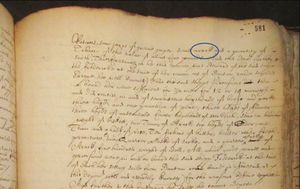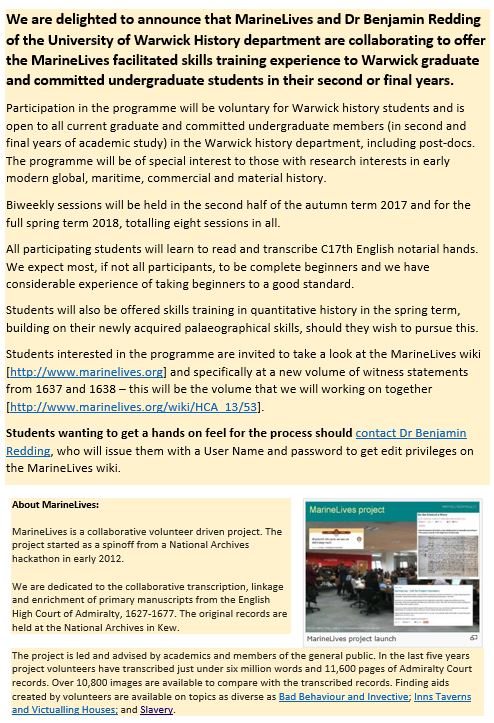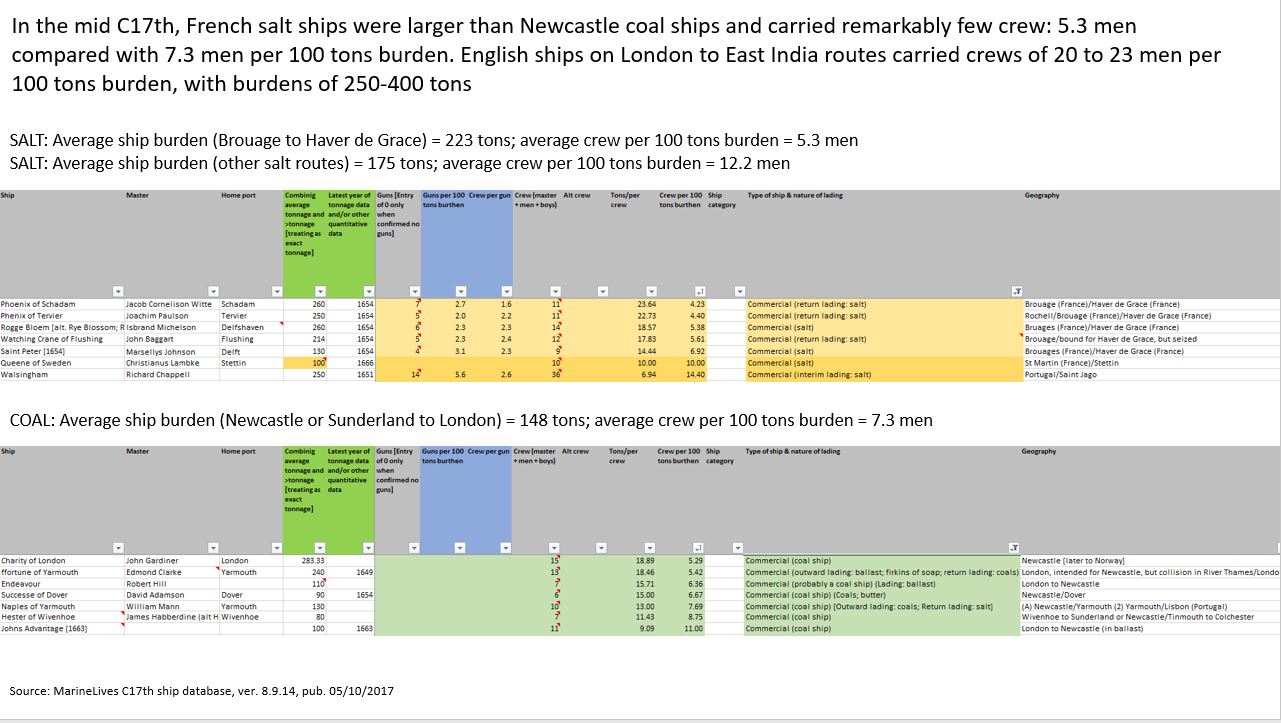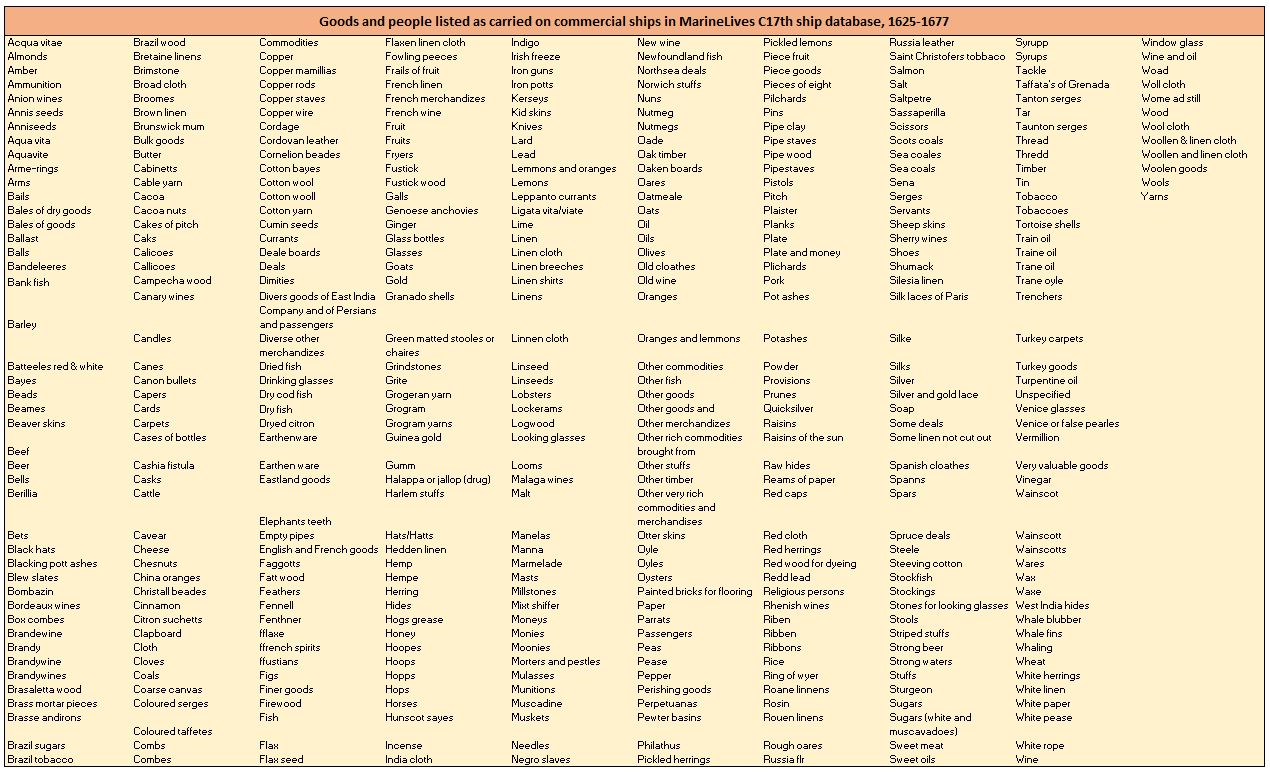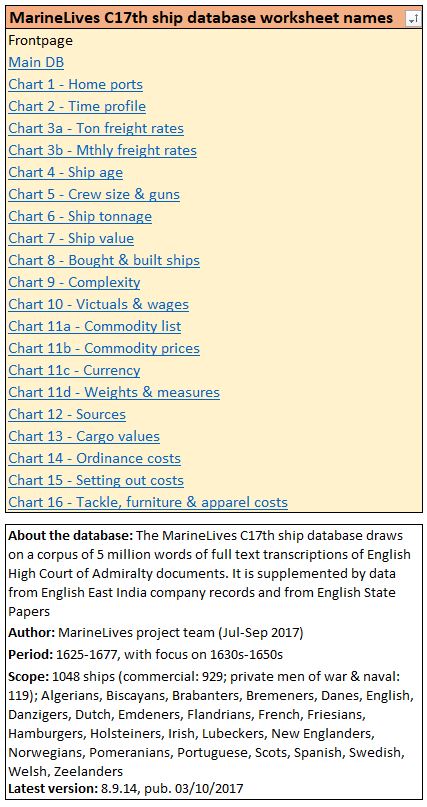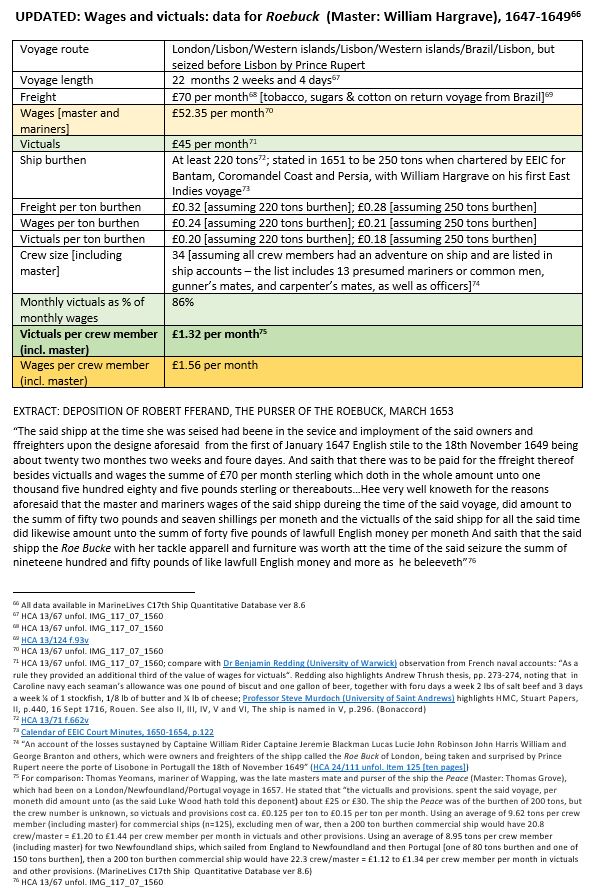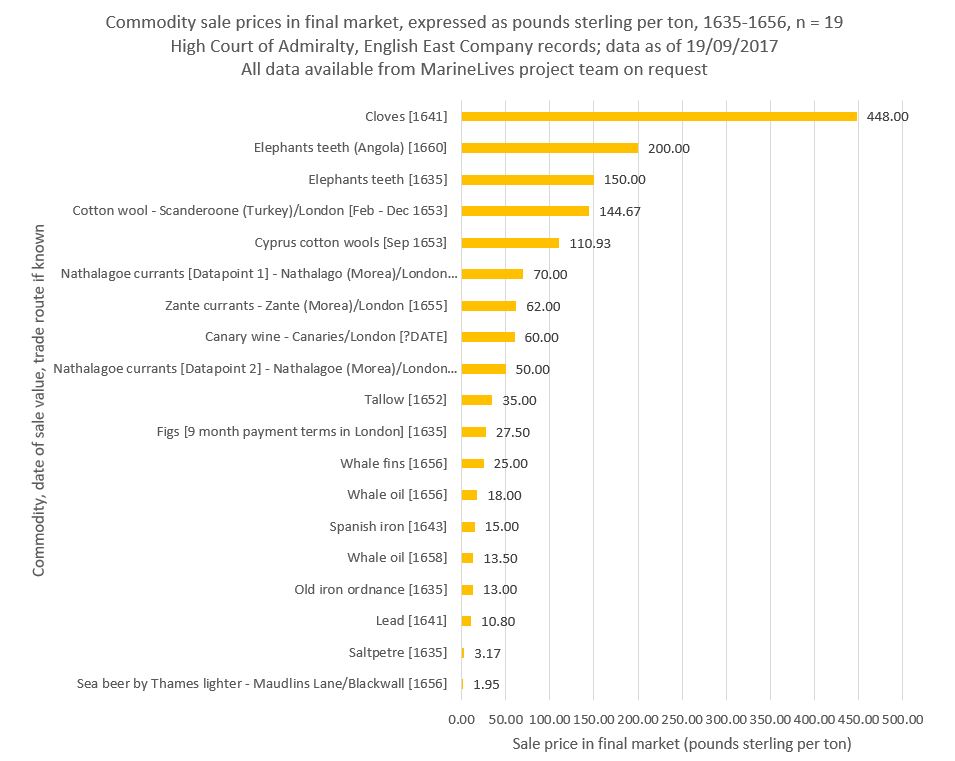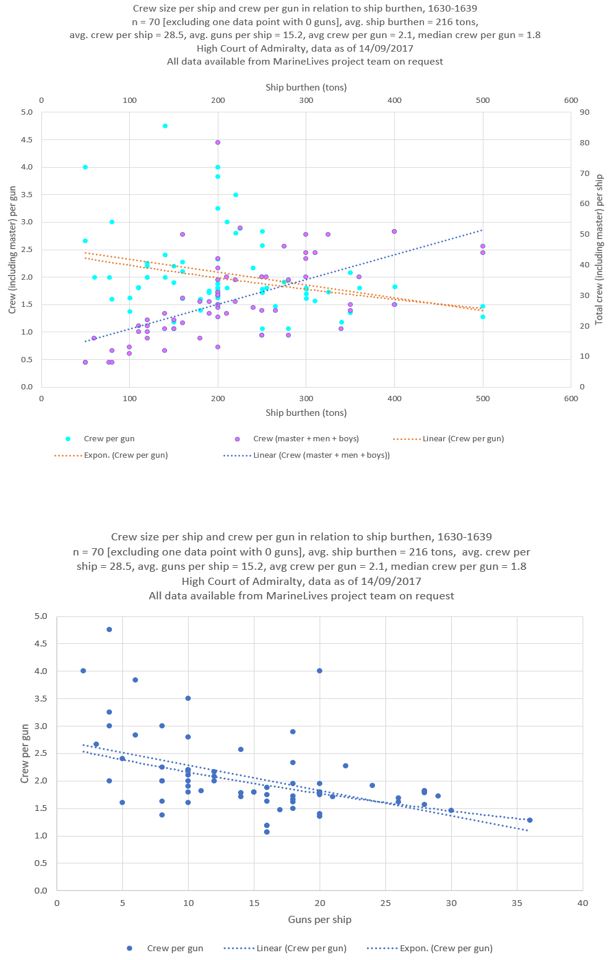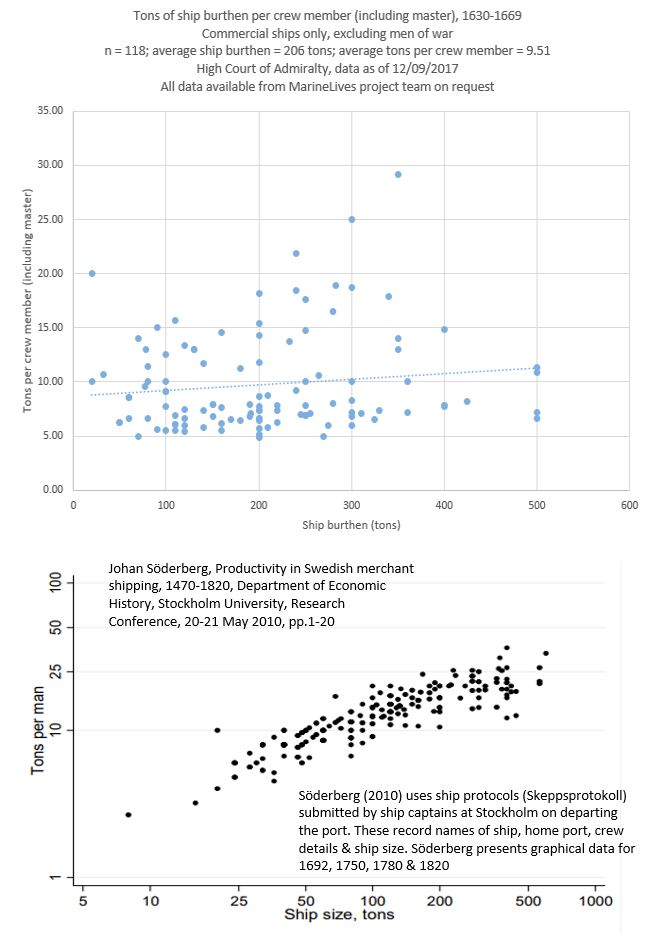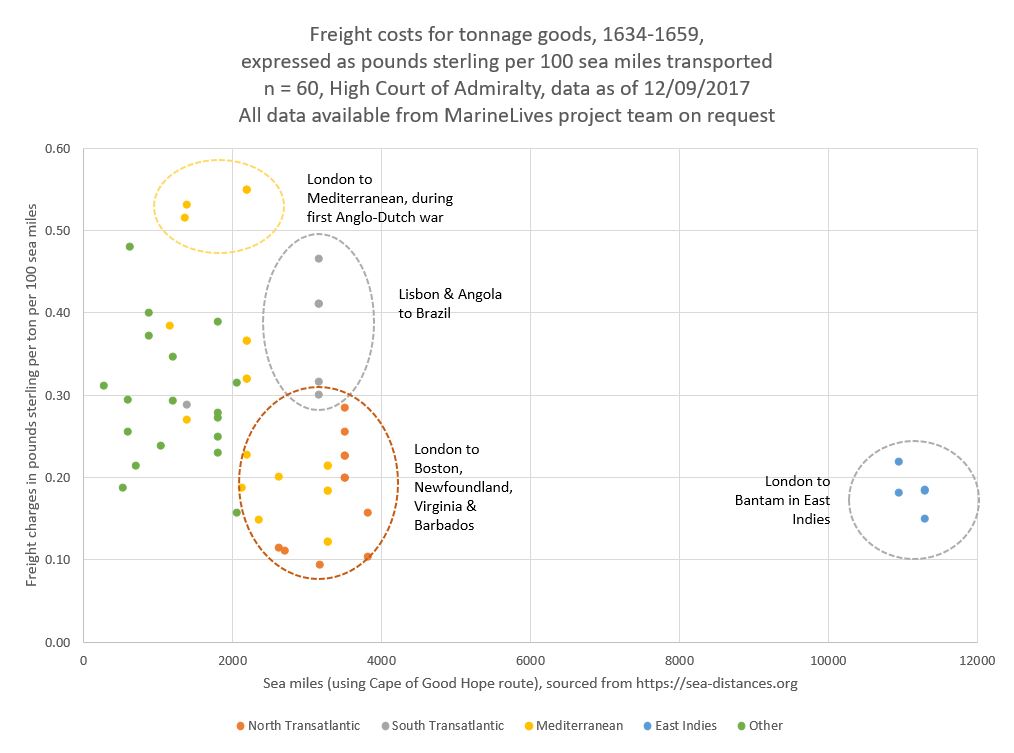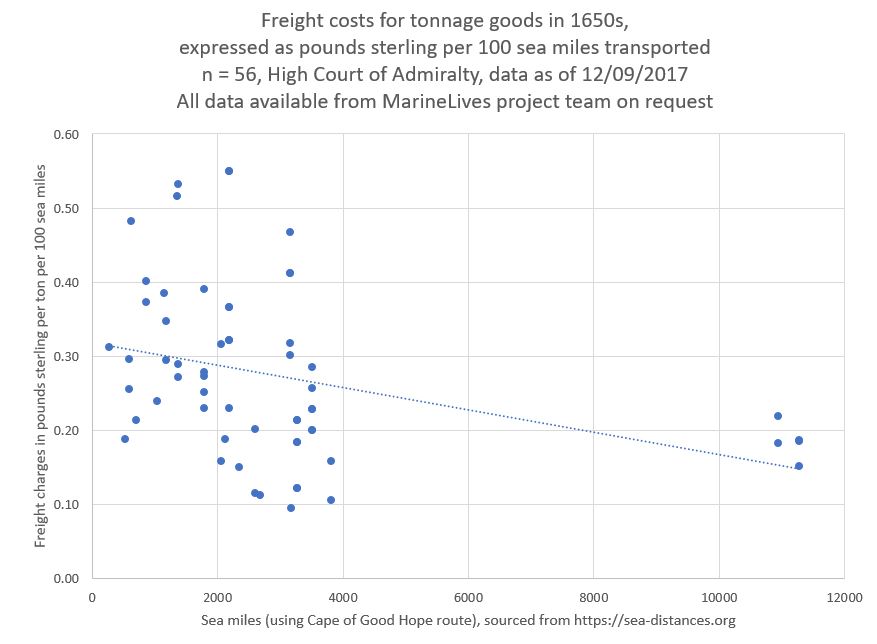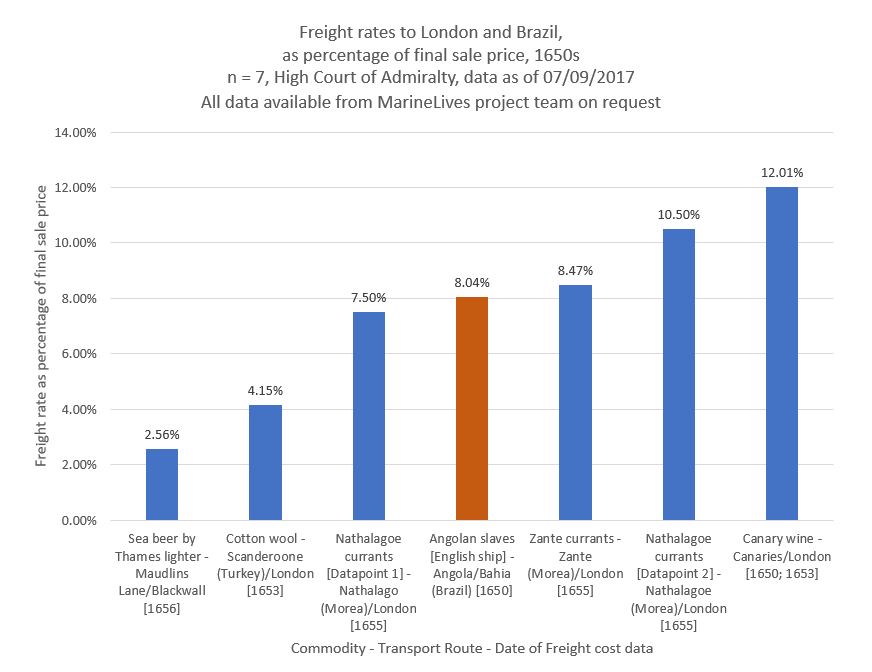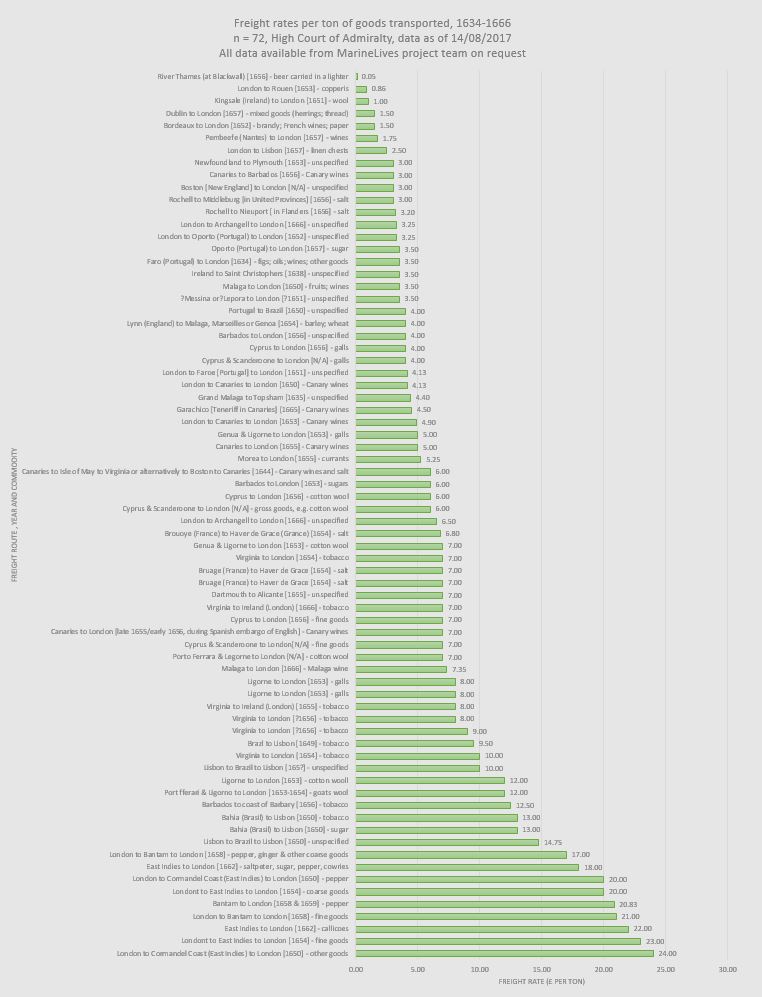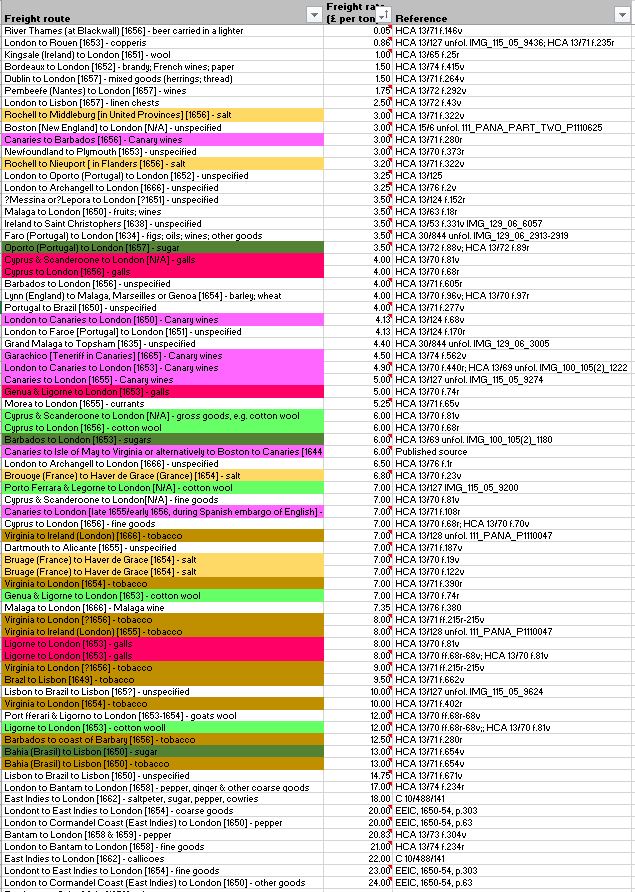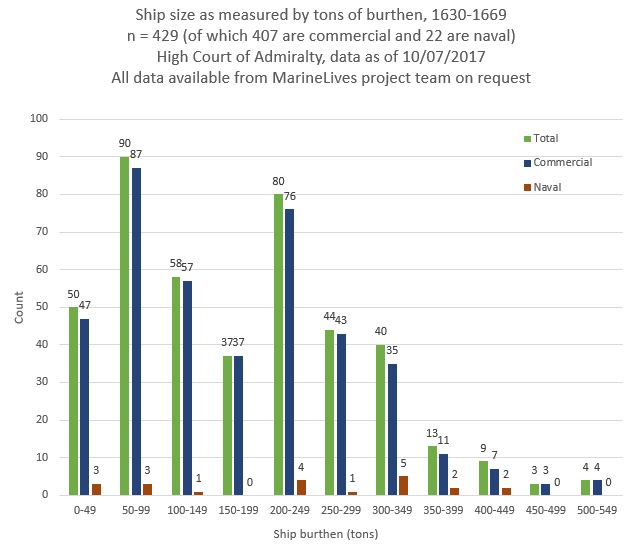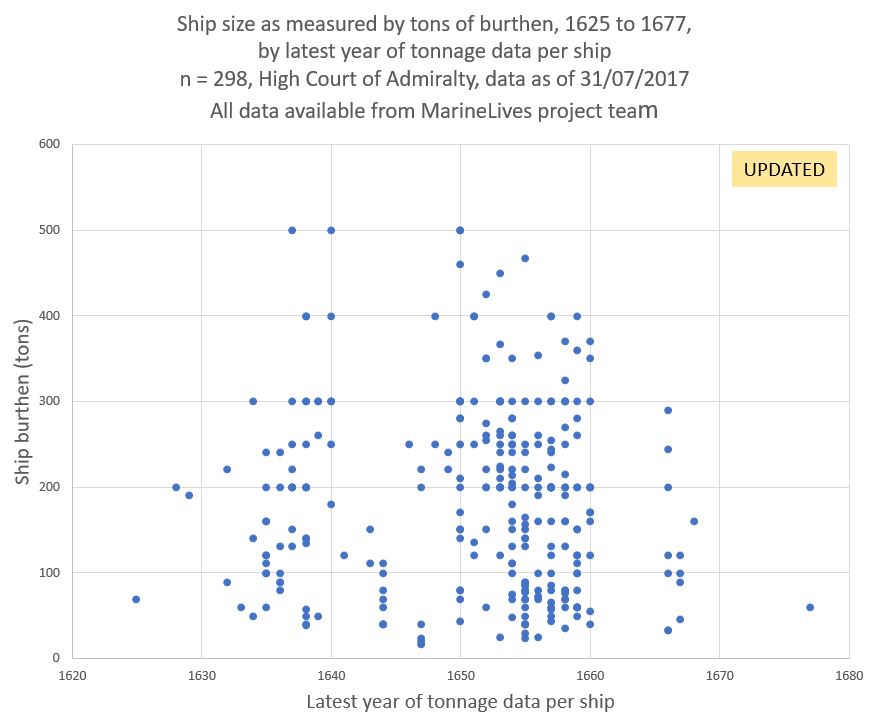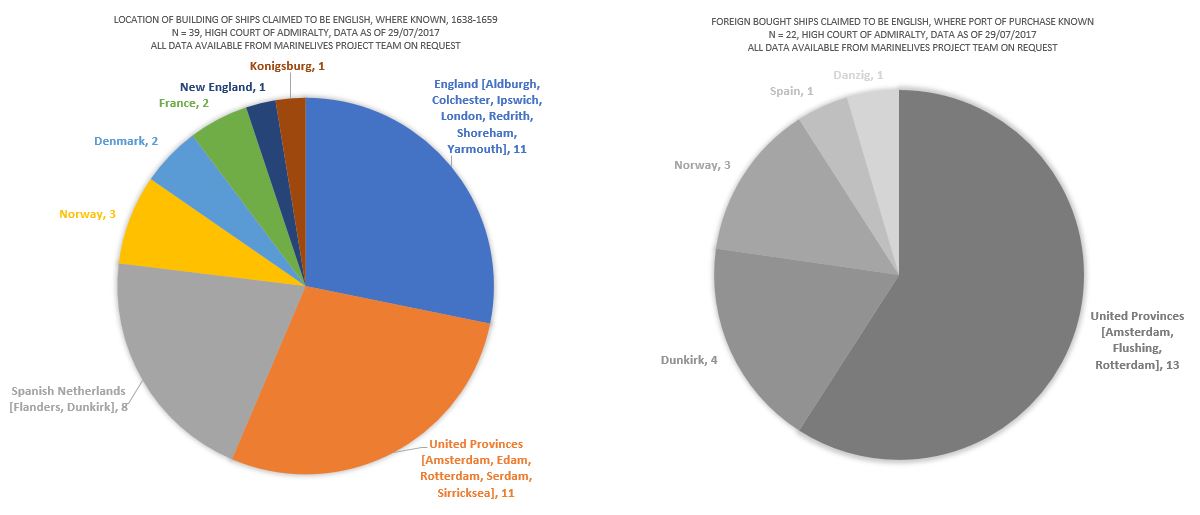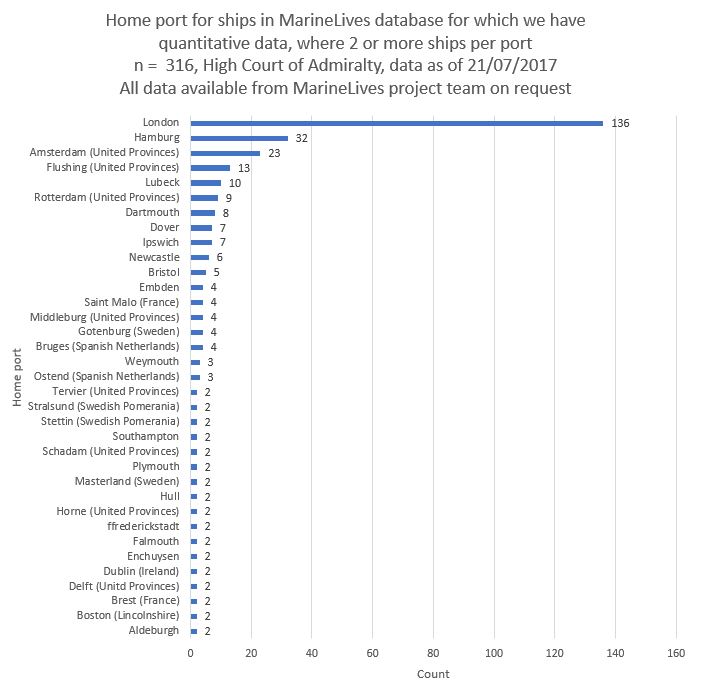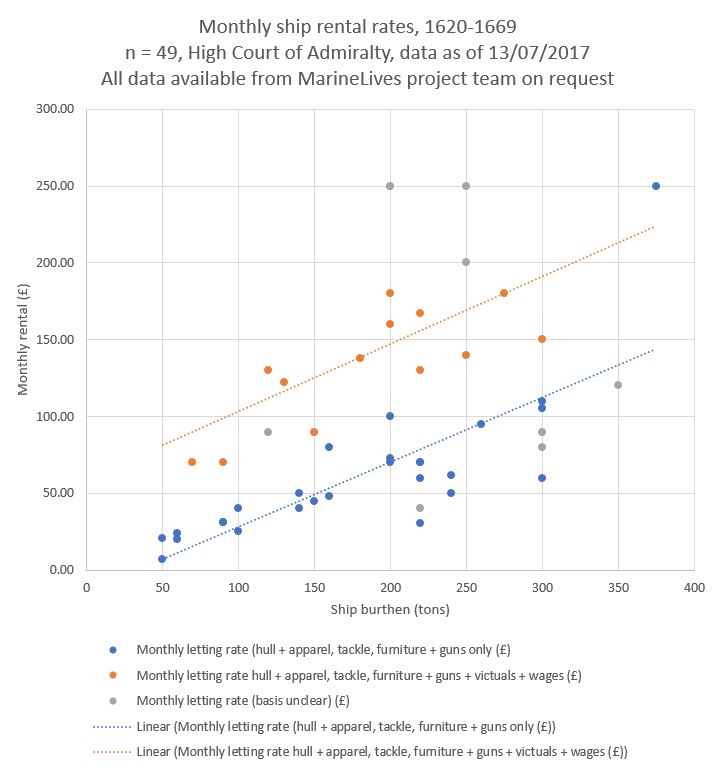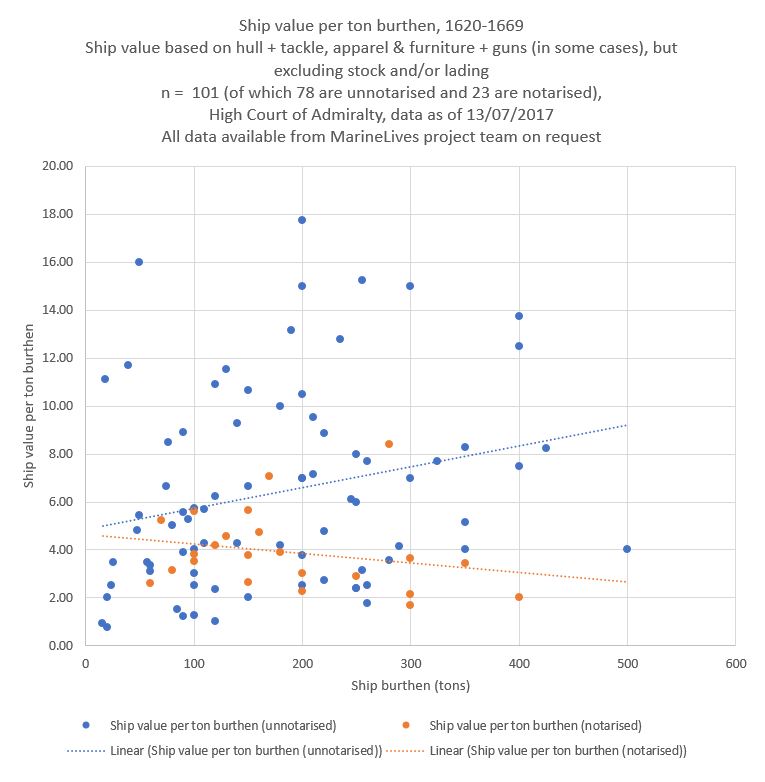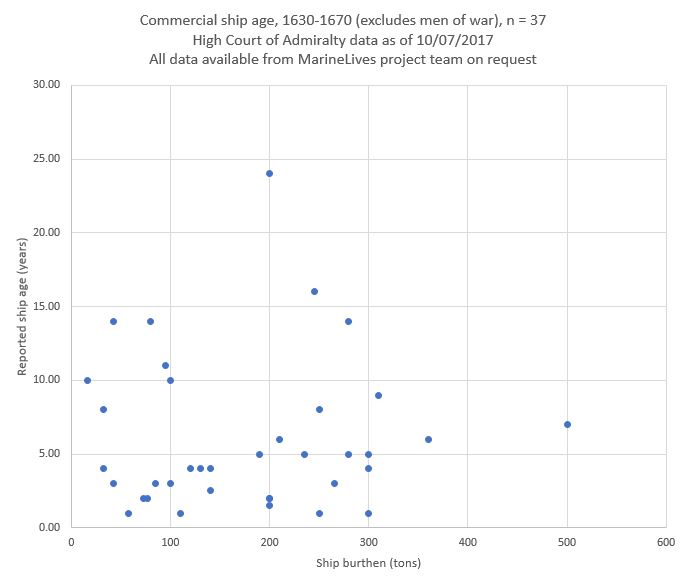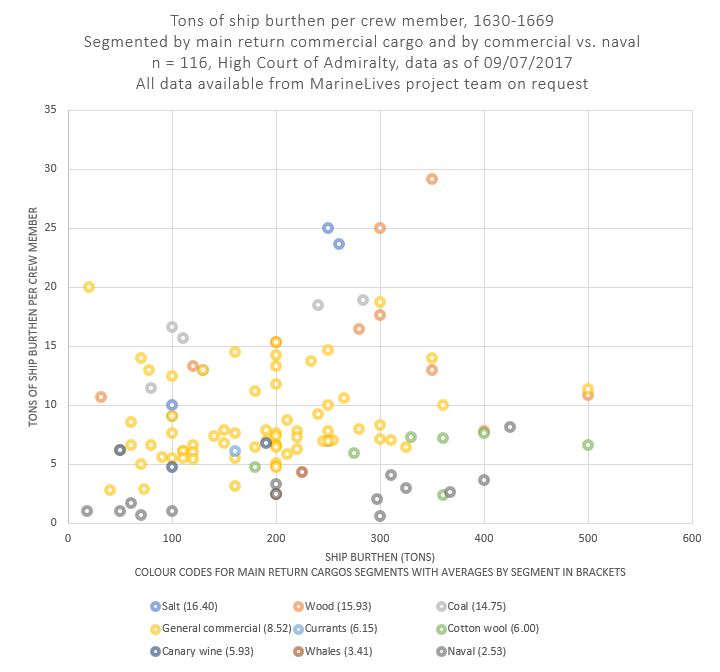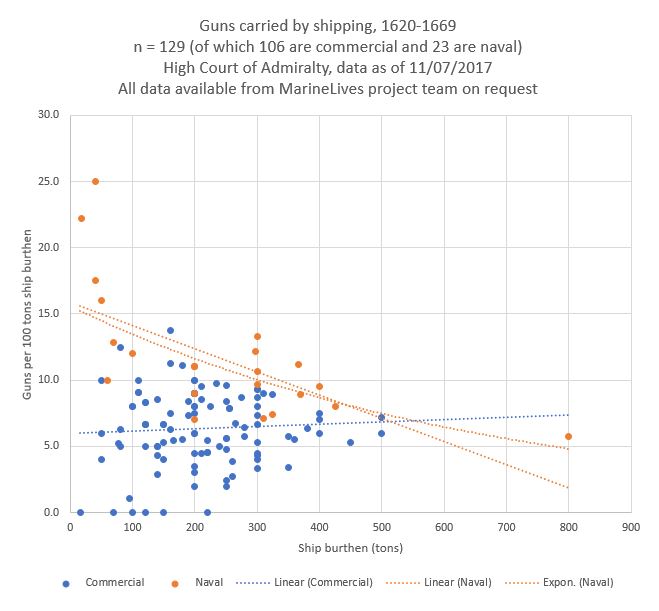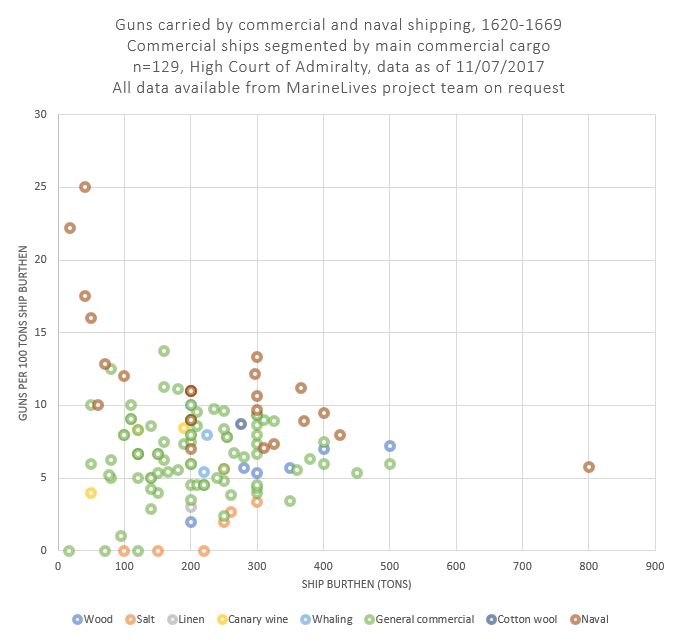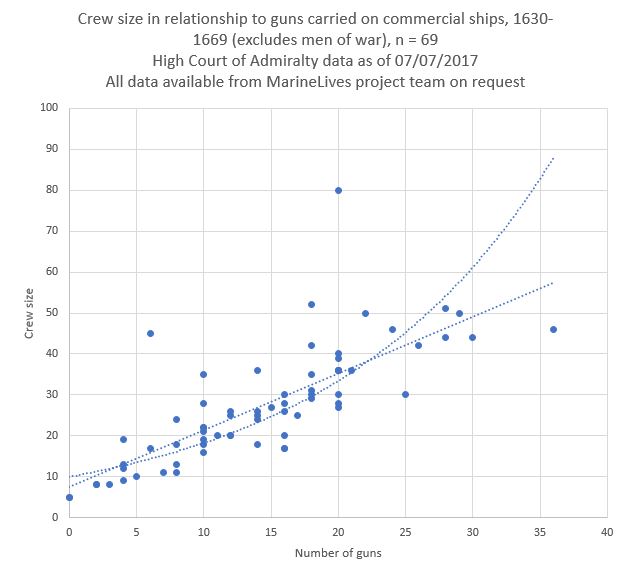FrontPageArchive14102021
Dr Benjamin Redding, a naval historian at the University of Warwick, is collaborating with Colin Greenstreet, co-director of MarineLives, to co-facilitate palaeography training for University of Warwick History students. The collaboration kicked off in late 2017 and is now in its third month.
Two of the six Warwick students participating in the group share their experiences below.
Celine Romano is a second year History student at the University of Warwick. Her interests in history range from early modern material history and its socio-political importance, to the philosophy of the Enlightenment.
"I remember I was sitting waiting for one of my lectures, when someone came to the front and announced this volunteer project within the history department. I didn’t catch much, but when Dr. Redding mentioned engaging with primary sources I perked up, and I’m glad I did. Marine Lives has been a really valuable experience as it’s taught me a new palaeographic skills. Some people complain about student handwriting; I can now assure them, they are clearer than some 17th century scripts!
I had just finished a week on maritime empires for one of my history modules, in which we discussed the bill of rights system and roguish sailors swapping flags. It seemed interesting, but the High Admiralty Court was still quite abstract. Through Marine Lives, I’ve gained a better understanding of the actuality of maritime trade and legal spheres than through secondary texts: it was something real, that individuals engaged with.The sources themselves have expanded my awareness of how to engage with Early Modern History. For example, we studied the exchange of foodstuffs and dietary cultures across oceans in class. At the same time, I was transcribing HCA 13/72 f.581r, which is a catalogue of all the provisions the crew would need for their trip. In it, I found mention of 'Arack', or 'Arak' – mostly because I didn’t know if it was a real word or how to spell it. With some research, I realised that it was a Middle Eastern liqueur, in a European ship in the East Indies (Batavia, or modern day Jakarta).
Marine Lives has been an eye opening experience to the interconnectedness of the seas and the communities that surround it. It has also helped me learn palaeography, which I look forward to using in my career as a historian."
Joshua Callaway is currently a second year student at the University of Warwick, studying History with Italian. He has a keen interest in Early Modern European History, particularly aspects of the Military Revolution debate. He is considering a MA in Italy after his undergraduate degree to pursue these ideas further.
"Warwick University’s collaboration with MarineLives has equipped us with a new range of palaeographical and transcription skills, and invited us to broaden our general academic and historiographical approach. Engaging with documents in the new way that MarineLives offers, we have been able to garner a far more personal and intimate appreciation of the mid-17th Century, and the multitude of characters that helped to influence it. After several weeks initially developing our basic understanding of calligraphic styles, we have been given the opportunity to collaborate on documents from the Huntingdon Library Collection.
Our first session involved coming to grips with the Huntingdon’s Ellesmere Collection, which drew our attention to the interesting case of merchant Humphrey Slaney and Captain Thomas King. The document, which was presented in the form of a series of preparatory legal notes, elucidates the nature of naval quarrels, and how they were legally dealt with. The second document was an analysis of the state of the English navy; its decay, charges and future prospects. Personally, I found the different style of both of these documents paleographically challenging. However, cooperation between the Warwick transcribers has allowed us to develop our transcribing skills even further. We are appreciative of the historical opportunities that this project has given us, and we are looking forward to continuing to work on material from the Huntingdon’s collection."
Contents
About MarineLives
MarineLives is a collaborative volunteer driven project. The project started as a spinoff from a National Archives hackathon in early 2012. We are dedicated to the collaborative transcription, linkage and enrichment of primary manuscripts from the English High Court of Admiralty, 1627 to 1677, together with thematically related manuscripts from international manuscript and printed document collections
Currently, we have 12,757 text pages and 12,167 images available and nearly six million words of full text transcriptions on the MarineLives wiki.
In autumn 2017 and spring 2018 we will be working together with current graduates and second and final year undergraduate members of the University of Warwick History department to make a start on transcribing a volume of witness statements from 1637 and 1638.
We also welcome non-university based volunteers from all occupations and will give you the same training and facilitation our Warwick graduate and undergraduate volunteers will be receiving. Our volunteers have included former merchant sailors, teachers, archivists, homemakers and web designers.
Our latest group of volunteers started working in January 2018, and we still have room for more people to join this group.
Sample our training material to see if this could be for you.
This week's Feature: Communal C17th Textiles, Garments & Dyestuffs glossary
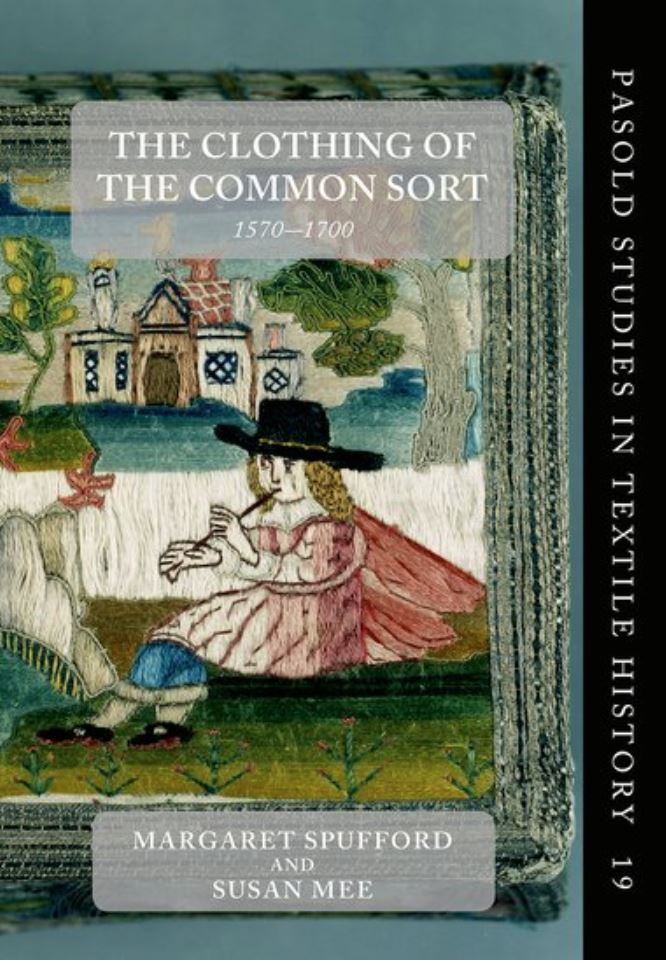
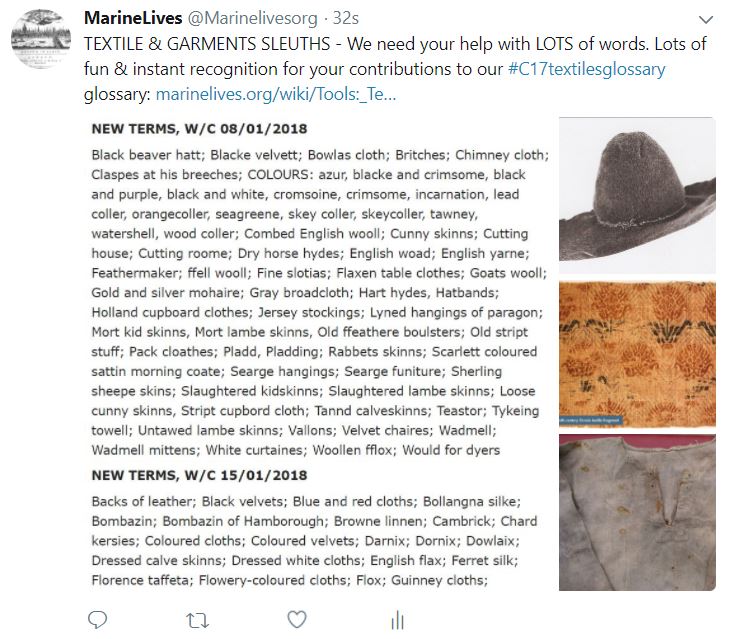
Purpose
On December 24th, 2017, The MarineLives team launched a communally created glossary of textiles, garments, & dyes, with terms and examples taken from early and mid-C17th English High Court of Admiralty documents, second half of the C17th Chancery Court documents relating to commercial disputes, second half of the C17th Prerogative Court of Canterbury merchants' inventories, and a London coastal portbook from the 1650s.
The terms are referenced to primary manuscript sources, typically linked to manuscript images and full text transcriptions. As of 18/01/2018, the glossary contains ca. 1000 terms, with contributions from thirty individuals.
Contributing to the glossary
We are using the @Marinelivesorg Twitter account to solicit new commentary and edits on specific terms, which we are incorporating into the glossary. We will acknowledge all contributions, but reserve the right (with the agreement of contributors) to make small editorial changes. Recent tweets related to the glossary can be found at #C17textilesglossary
Contributors
In alphabetical order:
Dr Kimberly Alexander, Dr Aaron Allen, Dr Carolyn Arena, Cynthia Chin, Nicola Clarke, Freyalynn Close-Hainsworth, Eglantine, Dr Karwan Fatah-Black, Helen Good, Colin Greenstreet, Tracey E Griffiths, Viveka Hansen, Dave Henderson, Dr Stefan Hessbrüggen-Walter, Jeffrey Hopper; Heather Knight, Dr Marcin Krygier, M.L. Logue, Dr Angela McShane, the pseudonymous Mapnut, Paula Marmor, Menno Jonker, Angela Middleton, Frances Owen, Tim Parry-Williams, Mark Ponte, Dr Michael Pearce, Elizabeth Pimblett, Dr Sophie Pitman, Dr Jo Pugh, Dr Deborah Sherlock, Dr Stephen Snelders, Ian Stoll, Peter Taylor, Dr Samantha Thompson, Rebecca Unsworth
Our vision: Lives touched by the marine, 1627-1677
Volunteering with MarineLives
We would like to recognise and thank all those who have contributed to the MarineLives project, to the Maphackathon event, to the Early Modern Textiles, Garments and Dyestuffs glossary and to the Signs of Literacy initiative (in alphabetical order), whether as volunteer transcribers, annotators, commentators, glossary contributors, advisors, interviewees, workshop participants, or PhD Forum participants.
Dr Aquiles Alencar-Brayner
Dr Kimberly Alexander
Christian Algar
Dr Aaron Allen
Elizabeth Ames
Dr Roberta Anderson
Vicky Annand
Dr Carolyn Arena
Deborah Ashby
Dr Gary Baker
Gabor Bakos
Iona Bartzi
Rachel Bates
Rowan Beentje
Nga Bellis-Phan
Michael Bennett
Amber Berkeley
Dr Richard Blakemore
Lior Blum
Ffion Boyd
Katie Broke
Dr James Brown
Dr Andy Burn
Elio Calcagno
Joshua Calloway
Michelle María Early Capistrán
Rachel Carter
Cynthia Chin
Nicola Clarke
Freyalyn Close-Hainsworth
Dalton Coker
Dr Giovanni Colavizza
Dr Justin Colson
Sam Cottrell
Kevin Daniells
Thierry Daunois
Dr John Davies
Thomas Davies
Jonathan Dent
Melvyn Dresner
Dr Stuart Dunn
Professor Kai Eckert
Bob Egan
Eglantine
Dr Charlene Eska
Louise Falcini
Emilie-Jane Farrimond
Dr Karwah Fatah-Black
Dr Amelia Fay
Dr Janet Few
Christian Folgar
Sara Fox
Dr Anthony Firth
Erin French
Dr Ian Friel
Professor Cheryl Fury
Steve Garnett
Dr Perry Gauci
Marja Geesink
Jaap Geraerts
Helen Good
Dr Jamie LH Goodall
Guy Grannum
Colin Greenstreet
Francesca Greenstreet
Justin Grierson
Tracey E Griffiths
Dr Adam Grimshaw
Karen Gunnell
Yerevag Hagopian
Dr Mark Hailwood
Kevin Hall
Finn Halligan
Viveka Hansen
Elaine Harrington
Dr Liam Haydon
Phillipa Hellawell
Laura Herbert
Dr Helmer Helmers
Dave Henderson
Dr Stefan Hessbrüggen-Walter
Professor Tracey Hill
Professor Tim Hitchcock
Dr Philip Hnatkovich
Rachel E. Holmes
Jeffrey Hopper
Dr Jenni Hyde
Dr Tom Irvine
Steve Ives
Alex Jackson
Stefan Jäggi
Elin Jones
Sue Jones
Menno Jonker
Dr Sam Kaislaniemi
Ross Keel
Dr Patricia Keller
William Kellett
Sara J Kerr
Heather Knight
Iris Kramer
Dr Marcin Krygier
John Kuhn
Dr Craig Lambert
John Layt
Deborah Leem
Dr Sjoerd Levelt
Amalia Skarlatou Levi
John Levin
M. L. Logue
Jelle van Lottum
Ismail Malik
Grace Mallon
Paula Marmor
Simon Marsh
Dr Alan Marshall
Dr Barbara McGillivray
Dr Angela McShane
Angela Middleton
John Miller
Anne Mills
Kate Morant
Matthias Müller-Prove
Professor Steve Murdoch
Dr Shavana Musa
Maurice Nicolson
Stephanie Ostrich
Frances Owen
Gordon O'Sullivan
Dr Katherine Parker
Tim Parry-Williams
David Pashley
Dr Michael Pearce
Dr Cathryn Pearce
Elizabeth Pimblett
Dr Sophie Pittman
Professor Simone Paolo Ponzetto
Mark Ponte
Dr Peter Pridal
Dr Jo Pugh
Seif Al Rashidi
Dr Peter Rauxloh
Patrizia Rebulla
Dr Benjamin Redding
Jarmila Regulova
Bethan Reynolds
Daniel Richards
Harriet Richardson
Andrew Richens
Dr Mia Ridge
Dr Dominique Ritze
Dr Gavin Robinson
Glen Robson
Dr Helen Rogers
Dr Jill Rogers
Axel Hee Rømer
Celine Romano
Dr Margaret Schotte
Steven Schrum
Dr Louise Seaward
Andrei Seleznov
Laura Seymour
John Sheridan
Dr Deborah Sherlock
Dr Rainer Simon
Ida Sjoberg
Petr Sloup
Dr Edmond Smith
Tilly Smith
Dr Stephen Snelders
Professor Humphrey Southall
Dr Craig Spence
Daniel Stewart-Roberts
Dr Hannah Steyne
Ian Stoll
Michael Stoner
Dr Chad Stolper
Peter Taylor
Dr Carl Thompson
Dr Samantha Thompson
Roger Towner
Dr Alexis Truax
Dr William Tullett
Martin Turner
Oliver Turner
David Underdown
Rebecca Unsworth
Dr Brodie Waddell
Rebecca Want
Samuel Watson
Dominic Webb
Ken Whittaker
Jill Wilcox
Peter Williams
Royline Williams-Fontenelle
Ad van der Zee
Dr Kathrin Zickermann
Dr Suze Zijlstra
Dr Cäcilia Zirn
and the ever helpful Gijs Boink, formerly the anonymous @_mapnut
Katherine Parker was a Ph.D. candidate at the University of Pittsburgh. She has now completed her dissertation entitled “Toward a more ‘perfect knowledge': British geographic knowledge and South Seas exploration in the eighteenth century. She participated in the MarineLives Ph.D. forum in 2013, and the MarineLives summer programme in 2014:
"On summer research trips to London in 2011 and 2012, I had looked at a few HCA documents and knew that the cases recorded in them offered rich material for social, economic, and naval history. Over the course of several skype meetings, I and other PhD students got to give our opinions about the proposed platform and methodology for transcription. Working with a team created a strong community aspect to the project from the beginning; I have always been impressed by the inclusiveness and openness that drives MarineLives. Also, it was refreshing to have my opinion valued as a PhD student, as sometimes that stage in one’s education is isolating and transitional—you are not yet qualified as an expert, but also not unknowledgeable about certain fields.
The value MarineLives placed on the voices of the PhD forum made me want to participate further, even though the works being transcribed were not strictly within the chronological bounds of my dissertation project. Thus, when the summer transcription project was created, I jumped at the opportunity to use paleographic and transcription skills I had gained after a year in London archives on a Social Sciences Doctoral Dissertation Fellowship (2013-14).
Writing styles change over time, just like clothing and furniture styles. Thus, the letters inscribed within HCA volumes from the mid-seventeenth century posed a challenge for me, as I am used to the fluid, upright cursive (often written by a trained scribe or clerk) of the mid-eighteenth-century Admiralty. I came to enjoy the challenge of squinting at the digital pages in front of me, willing the words to make sense, filling in paragraphs slowly until suddenly they all made sense."
Thomas Davies was a third year history undergraduate student studying at Bath Spa University. In the summer of 2014, Thomas was a member of a four person virtual team of volunteers transcribing Admiralty Court witness statements from 1658 to 1660, facilitated by Dr. Philip Hnatkovich in Pennsylvania:
"MarineLives created a Bath Spa student section that helped me significantly, showing templates of letters and the different forms they have. This allowed me to tackle the many different writing styles the clerks used. Once I was able to distinguish between letters more clearly with considerable practise, I found I could transcribe enough of the page to get a good idea of what was being said in the documents. Then, I could alter words that did not fit within the context of the deposition, or using the context as a guideline as to what certain words should be.
The biggest challenge I faced in the transcription itself was becoming accustomed to the peculiar writing and distinguishing letters. Some letters look very similar, such as f’s and s’s, r’s and c’s not to mention t’s and l’s. I began transcribing effectively by taking it slow and working out the letters individually instead of looking at the word as a whole as we do with modern writing. I found this approach to be very effective.
The Silver Ships research project
Three large ships (The Salvador, the Sampson and the Saint George), of supposed Lubeck and Hamburg build and ownership, were captured by the English in 1652 with highly valuable cargos of silver bullion.
The ships were on their way from Cadiz with bullion from the Spanish West Indies going northwards. It was disputed in the English Admiralty Court as to whether the ships were bound legally for the Spanish Netherlands, or illegally for Amsterdam.
The case was endowed with political as well as commercial weight - the Commonwealth, and then the Protectorate, was keen to have the bullion declared lawfull prize, but the Spanish government contested this.
The many and varied court depositions and other English Admiralty (and English and Spanish State Paper) records give very granular and highly colourful accounts of Seville and Cadiz, Hamburg and Lubeck, the Spanish Netherlands, the by-ways between the Spanish Netherlands and Amsterdam by which bullion could be smuggled overland and by canal, and the River Thames, where the ships and sailors were held following seizure.
Thomas Violet, a rather dodgy goldsmith, was involved as an agitator on behalf of the State, and published a pamphlet pleading for reimbursement of his efforts, which supplements the Admiralty Court material on the MarineLives wiki.
The Silver Ships project was launched by participants in the MarineLives 2015 summer transcription training programme and continues to be driven by volunteers.
Click to read more about the Silver ships and the historical and legal context of the resulting disputes.
How to make money in C17th commercial shipping?
The MarineLives project team continues to look at the drivers of profit and loss in C17th commercial shipping. We are publishing as we go and welcome comments, contradiction, and offers of help and data.
Please contact us if you would like to learn more about this research and how you can help, or if you would more generally like to learn about the work of MarineLives volunteers.
The charts accompanying the database hint at the power of this approach, which integrates the micro and the macro, and which covers shipping across multiple countries, seas and oceans.
We would greatly appreciate your input on where to take this work
- Research questions to ask
- Ways to explore and structure the data
- Institutions who may be interested in supporting our work, whether with data, expertise or other resources
- Individuals and charitable bodies, who may wish to support our work
Please tweet us or email us with your ideas and to request copies of the latest database, which is available to all, free of charge.
This puts victuals (that is food and drink) at 86% of wages, a proportion which is higher than suggested by examination of French naval accounts.
As context, 12d sterling per day per person was payed by Rene Louis de Cornouaille to to twelve mariners "for their dyet" for a period of five weeks, following the arrest of the ship the Julian until its release. This is £1.50 per person per month, assuming a thirty day month. The mariners were probably located in London during this time.[3]
A lower amount of 8d sterling a day per person was assessed for "victualling" of the 90 person company of the prize ship the Julian Cavalier (also known as the Successe), which had been taken from the French by ships of the English Parliament in 1651. This is £1.00 per person per month, assuming a thirty day month.[4]
As further context, the daily cost of a negro slave's "diet" in Angola in April 1650 is given in a High Court of Admiralty source as "ryall 40 rees or 6d sterling a day per heade", which is £0.75 per person per month, assuming a thirty day month.[5]
English Naval Estimates from September 1650 provide data on both victuals and wages as estimated by the Committee of the Navy.
- For twenty ships manned with 3,000 men for three months on the coast of Portugal, sea victuals were estimated at £1.50 per man per month (30 shillings) and sea wages were estimated at £1.40 per man per month (28 shillings).
- The same rates were estimated for a further twelve ships manned with 2,000 men for four months on the coast of Portugal.
- Slightly different estimates are given from the same source for forty ships and vessels manned with 4,200 men for six months on the coasts of England, Ireland and Scotland for the coming winter. Harbour victuals were estimated at thirty shillings per man for six weeks, so a rate of £1.00 per man per month, with harbour wages for the same men, also for six weeks, estimated at forty shillings, so a rate of £1.33 per man per month. In contrast, sea victuals were estimated for six months for 4,200 men at £1.25 per man month (25 shillings) and sea wages for the same period and same men also at £1.25 per man month (25 shillings).[6]
Further work is clearly required, and we welcome comment from academics and non-academics on our data and analysis.
Thanks to Professor Steve Murdoch, Dr Benjamin Redding, Professor Cheryl Fury and Steve Garnett for their comments and suggestions.
Our tentative answer
Michael Pearce asked us on Twitter whether more guns mean more crew, irrespective of ship burden.
Below is our tentative answer:
Our data suggest greater variation in crew per gun amongst smaller ships (up to say 200-250 tons) and for ships carrying fewer guns (say up to 10 guns per ship). Moreover, the data suggest a decline in crew per gun as ship size and gun number per ship increase.
Arguably, there is a minimum number of crew per gun of 1 per gun, and that the effective minimum is around 1.4 or 1.5 crew per gun.
Ships of 250 tons burthen and below have significantly higher crew per gun:
50-99 tons = 2.5 crew/gun, n = 6
100-149 tons = 2.2 crew/gun, n = 11
150-199 tons = 1.8 crew/gun, n = 10
200-249 tons = 2.4 crew/gun, n = 18
250-299 tons = 1.8 crew/gun, n = 10
300-349 tons = 1.6 crew/gun, n = 7
350-399 tons = 1.7 crew/gun, n = 3
400-499 tons = 1.7 crew/gun, n = 3
500 tons = 1.4 crew/gun, n = 2.
Arguably, increased gun number on smaller ships and for those with relatively few guns, had no impact on crew levels because of typically high crew to gun ratios for these ships, which could simply be reduced when more guns were added, without ading more crew.
It is only when crew to gun ratios get towards 1.4 or 1.5 that additional guns, for any particular ship burden, lead to rising crew numbers and falling man per ton ratios.
Note that this dataset of n = 70 is contained within the larger dataset of n = 118, used to create a further chart, two charts below this one. For this smaller dataset we have selected only ships where we have ship burthen, crew size and number of guns. One ship has been removed with zero guns to facilitate the fitting of an exponential curve.
Tweet us or email us with your ideas.
How might we explain these data?
Presented without reference to ship burthen, there appears to be an inverse relationship between tons per crew member and guns per 100 tons ship burthen.
Note that this dataset of n=71 is contained within the larger dataset of n = 118, used to create the chart below. For this smaller dataset we have selected only ships where we have ship burthen, crew size and number of guns. The smaller dataset appears to show a slightly stronger correlation between tons per crew and ship burthen.
Tweet us or email us with your ideas.
The significantly higher tons per man ratios revealed in Söderberg's data for 1692 is likely to be influenced by product mix, with outward ladings from Stockholm presumably containing high proportions of iron, tar and pitch. These products required relatively low manning levels per ton
In our own English High Court of Admiralty data, which are largely for English ships, a small number of Swedish ships have a tons to man ratio of 12.92 (n = 2) and a slightly larger number of English and Swedish ships carrying tar, pitch and/or iron from Stockholm or Gotenberg to London have a tons to man ratio of 10.74 (n = 4).
Transport distances have been calculated using https://sea-distances.org.
The cost of transporting goods in time of war, with much higher risk of loss, could be two or more times higher than the costs of transporting goods in times of peace for the same goods and for the same transport distances.
Transport distances have been calculated using https://sea-distances.org.
The cost of lighterage per ton of sea beer from Maudlins Lane to Blackwall, both on the River Thames, was one shilling for beer worth 39 shillings per ton (2.56% of the value of the commodity) compared with an average freight rate per ton of Canary wine between 1650 and 1653 of £4.57 from the Canaries to London and an average sale price per ton of Canary wine in London in February 1650 of £38 (12.01% of the value of the commodity).
We currently have one example of the freight charges for transporting slaves from Africa across the Atlantic (from Angola to Bahia in Brazil). It is relatively unusual to see explicit freight charges for slaves, since many slaving voyages were conducted by the owners of ships on their own accounts, or by charter party per month, with monthly freight charges, as opposed to charges per slave.
Our example puts such freight charges at just over 8% of the sale price of an Angolan slave in Bahia, Brazil (3 mill 800 res to 4 mill res freight charges in 1650 versus the expected sale price per slave in Bahia in 1650 of 48 to 49 mill res).[7]
They include the freight rate of carrying a ton of beer by lighter in the river Thames at Blackwall in 1656 [£0.05 per ton, or an old shilling] through to the carrying of fine goods back from the East Indies to London in 1654 [£23.00 per ton]
They cover short transportation distances, such as London to Rouen and Kingsale in Ireland to London through medium distances, such as Cyprus and Scanderoone to London and Brazil to Lisbon, and long distances, such as Bantam in the East Indies to London.
Freight rates per ton were set according to distance and commodity, and reflect the different manning levels required for different types and length of voyage.
The outbreak of war had significant impact on tonnage based freight rates. For example, war between England and the United Provinces in the early 1650s, sharply pushed up freight rates on galls and cotton wool from the Eastern Mediterranean to London.
Driving the higher freight rates during times of war was the need to have higher manning levels on ships, higher mariner wages per man, and higher gun intensity per tun of ship burthen.
There are two clear peaks in the data for commercial ships - the first peak is in the 55 to 99 ton burthen category and the second peak is in the 200 to 249 ton burthen category.
Admiralty Court witnesses refer to ships of 50 and 60 tons as "small" and ships of 300 to 350 tons and above as "large". The smallest ton burthen category in our analysis (1-49 ton burthen) contains lighters, some barges and hoys, and other small river and coastal vessels.
The average burthen for ships whose latest tonnage information is in the 1630s = 176 tons (n = 54)
The average burthen for ships whose latest tonnage information is in the 1640s = 169 tons (n = 28)
The average burthen for ships whose latest tonnage information is in the 1650s = 191 tons (n = 191)
The average burthen for ships whose latest tonnage information is in the 1660s = 161 tons (n = 24)
The English locations for building include Norfolk, Suffolk, Essex, London and surrounds, and Suffolk. These data miss other obvious locations for ship building in England such as Newcastle, Devon and Dorset. Undoubtedly, ships contained in our High Court of Admralty database were built at these locations, but in the absence of specific confirmation they are excluded. The non-English locations for building are dominated by the United Provinces (Holland and Zeeland) and the Spanish Netherlands (Flanders).
The right-hand side chart shows the foreign ports where a number of ships claiming to be English were purchased. The data are dominated by the United Provinces, Dunkirk and Norway. These data under-represent the number of ships claiming to be English purchased from Norwegian owners, since a number of Norwegian owned ships were sailed to London and sold in the port of London, rather than in Norwegian ports.
We would be interested in our readers comments on these data.
Are the averages and ranges in the same ballpark as data in the hands of our readers, both from the C17th and earlier and later periods?
What can you tell us about the use to which these different types of commercial vessel were put?
Riverine versus coastal versus longer distance use? Cargo types? Crew and gun levels? Rental rates?
Our current dataset for monthly rentals consists of forty-nine ships.
Twenty-seven of these are rental rates for hull plus apparel, tackle, furniture and ordinance, but excluding provisions and wages, which were to be paid directly by the renting agent.
Fourteen are rental rates for hull plus apparel, tackle, furniture and ordinance and including provisions and wages, which were to be paid by the ship owner and recovered through the monthly rental. We know the monthly rental rates for three of these fourteen also on the basis of excluding provisions and wages.
Finally, we have eight rental rates for which it is unclear on what basis the rentals were contracted.
Our current dataset consists of one hundred and one ships, of which seventy-eight ship values are unnotarised and twenty-three ship values are notarised. Notarised values are lower (average = £3.90 per ton of ship burthen) comparised with unnotarised vales (average = ££6.40 per ton of ship burthen). Notarised values show a significantly tighter range around the average and mean than do unnotarised values.
We are working on disambiguating our data, but believe the differences in averages, means and range are due to the unnotarised data being more mixed in nature. Specifically, unnotarised data tends to be generated from witness statements of ship value following the seizure of a ship. We have excluded witness valuations of ships where it is clear that the outward, interim or return lading of the ship has been included in the witness valuation. Similarly, we have excluded witness valuations of ships where it is clear that an outward monetary stock has been included in the valuation.
However, even with these exclusions, the valuation of ships during their voyage usually includes some portion of the provisions carried on board the ship. If a seizure is early in a planned long voyage, these provisions could amount from anything between six and twenty months.
Moreover, the valuations of ships during their voyage will include some attribution of value to the refitting and setting out of a ship prior to a voyage, which can vary in the case of the hull from repairs to full graving and caulking or even resheathing, and in the case of the apparel, tackle and furniture, can include totally new provision of sails, rigging, blocks and other materials. Witnesses appear to make some allowance for the wear and tear of a ship on a long voyage and sometimes comment on this when giving their unnotarised valuations in their depositions in the High Court of Admiralty.
We plan to add ship inventories to our database, sourced from High Court of Admiralty appraisements of seized ships. These inventories will provide detailed breakdowns of the value of the physical components of ships in this period.
The average age of ships for which we have age and tonnage data is 6.1 years (n=37), whereas the average age of ships for which we have age data accurate to the year for which we have no tonnage data is 7.1 years (n=41).
Dr Ian Friel has shared with us a summary of data from his unpublished survey of High Court of Admiralty inventory documents from the 1580s. His data are for a period forty to eighty years earlier than our own High Court of Admiralty data. Ian's survey found ages for thirty-nine ships, with an average age of nearly fifteen years and twenty-nine of them of ten years or more in age.
Comparison of textual and numerical data for 1630-1670, with the bulk of the data from the 1650s, suggest Admiralty Court witnesses regarded ships aged between zero and five years as "new" and ships of fourteen years and above as "old".
The average crew size for the larger dataset is 47.3, including six exceptionally manned men of war with 275 or more men per ship (n = 172). The average crew size for the smaller dataset, where we have crew number and ship tonnage is 36.5 (n=116).
We are in the process of analysing these commercial data by geography and by commodity as well as by year to look for patterns within the commercial data.
Amongst the naval ships (a category which includes both ships in the immediate service of a state as well as private men of war under commissions from a state), there is a clear pattern for smaller ships to be particularly heavily gunned.
Commercial ships carrying salt had few if any guns, in contrast to ships carrying Canary wines or cotton wool as their main return cargos.
This is likely to be driven by the low manning levels on salt ships per ton of burthen. Low manning levels meant that there were fewer people available to man guns.
We are looking at relative freight rates for salt, Canary wines and cotton wool, and at sale prices for different commodities, to see if these also drove gun levels.
Coal ships are also likely to have had few if any guns. However, most of the coal ship cases in High Court of Admiralty data concern collisions, resulting in court cases which do not ask about guns. Whereas, most of the salt ship cases in the High Court of Admiralty data concern seizures, and elicit Court cases in which gun intensity is relevant and asked about.
As we dig further into the general commercial category, we should be able to allocate a good portion of these to specific commodity groups and thus be able to improve our analysis of the drivers of guns mounted on commercial ships
The average gun number for just men of war is 22.4 (n=2). The average gun number for just commercial ships is 12.8 (n=137). Our sample of commercial ships where we have tonnage as well as gun number (n=69) has a slightly higher average gun number than for all commercial ships, where only gun number is known.
The commercial gun number average overestimates the gun carrying propensity of commercial ships, since there is a systematic tendency not to report absence of guns from smaller vessels (vessels of thirty to sixty tons burthen). Many of these vessels, particularly those involved in coastal trade or fishing, as hoys, busses and ketches, would not have carried guns.
- ↑ HCA 13/71 f.649v
- ↑ 'House of Commons Journal Volume 6: 12 September 1650', in Journal of the House of Commons: Volume 6, 1648-1651 (London, 1802), pp. 467-468. British History Online http://www.british-history.ac.uk/commons-jrnl/vol6/pp467-468 [accessed 21 September 2017]
- ↑ HCA 15/6 unfol. 111_PANA_PART_TWO_P1110620
- ↑ HCA 13/64 unfol. IMG_125_05_2784
- ↑ HCA 13/71 f.649v
- ↑ 'House of Commons Journal Volume 6: 12 September 1650', in Journal of the House of Commons: Volume 6, 1648-1651 (London, 1802), pp. 467-468. British History Online http://www.british-history.ac.uk/commons-jrnl/vol6/pp467-468 [accessed 21 September 2017]
- ↑ HCA 13/71 f.644v; HCA 13/71 f.645r
